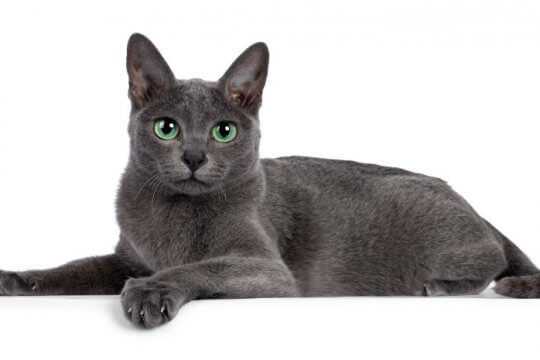Korat

Origin
Thailand
Height
10"-14"
Adult Weight
6-10 pounds
Life Span
12-15 years
TEMPERAMENT
Enchanting, strong-willed, alert, active
OTHER NAMES
Si Sawat cat, Malet cat, Good Luck cat
Group
Medium-sized short-haired
Price
$400-$2,000
Personality and Temperament
Care
- NUTRITION
- GROOMING
- EXERCISE
- HEALTH
Characteristics
History
The Breed Standard
Body
The body should be of small to medium size, with fine musculature. The cat should feel heavier than it appears.
Head
The Korat cat has a signature heart -shaped head. The eyebrow ridges form the heart's upper edges, and the sides of the face curve to the chin, completing the heart shape. When viewed in profile, the head should be well-defined, with a slight stop between the nose and forehead. The chin and jaw should be well-developed, but not sharply pointed or overly squared.
Eyes
The eyes should be large, round, and wide open, with a slightly Asian slant when closed or partially closed. Brilliant green is the preferred eye color, however an Amber cast is acceptable. Korat kittens and adolescents may display yellow to amber eyes. Final eye color is not fully achieved until maturity, normally between the age of 2 to 4 years.
Ears
The ears should be large, with flared bases and rounded tips. They should be set high on the head. Furnishings should be sparse.
Legs & Paws
The legs should be well proportioned, with the front legs being slightly shorter than the back legs. The paws should be oval shaped.
Tail
A Korat cat's tail should be of medium length, with a heavier base and a taper that ends in a rounded tip.
Coat
The Korat cat has a single hair coat that lies close to the body. The hair should be soft and silky.
Color
Korat cats should display silver-tipped blue coloring all over, with enough silver at the tips to create a silver halo effect. Kittens may display ghost tabby markings that fade with maturity. Adult Korat cats with ghost tabby markings or spots of any kind make wonderful pets but are disqualified from the show ring. The nose leather and lips should be lavender to dark blue. Paw pads should be dark blue or lavender with a pinkish tinge.
Frequently Asked Questions
-
How much does a Korat cat cost?
How much does a Korat cat cost?Korat cats cost between $400-$2,000. -
How big do Korat cats get?
How big do Korat cats get?Korat cats tend to be medium in size. A fully grown Korat cat might weigh between 6-10 pounds or more and range in height anywhere from about 10"-14" inches tall. -
How long do Korat cats live?
How long do Korat cats live?The Average lifespan for Korat is 12-15 years. -
Do Korat cats shed?
Do Korat cats shed?Korat are short-haired cats. Therefore, they do not shed as much as long-haired cat breeds.